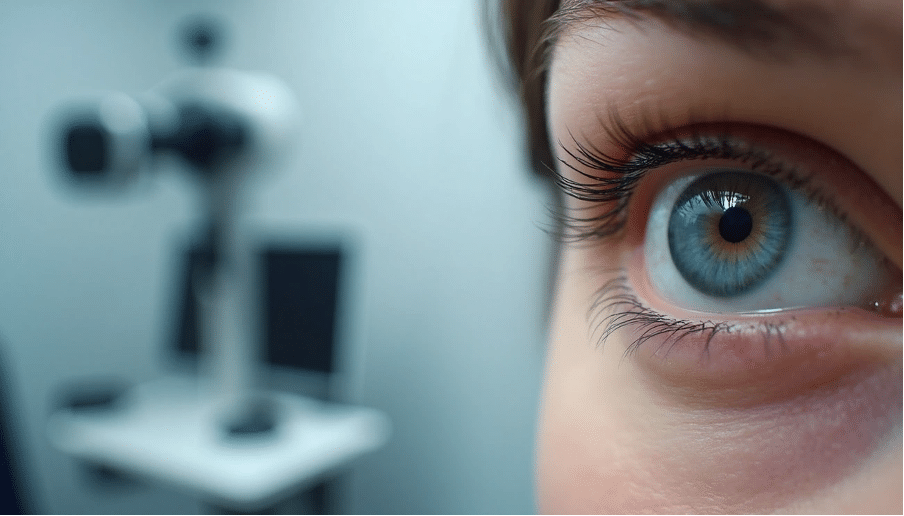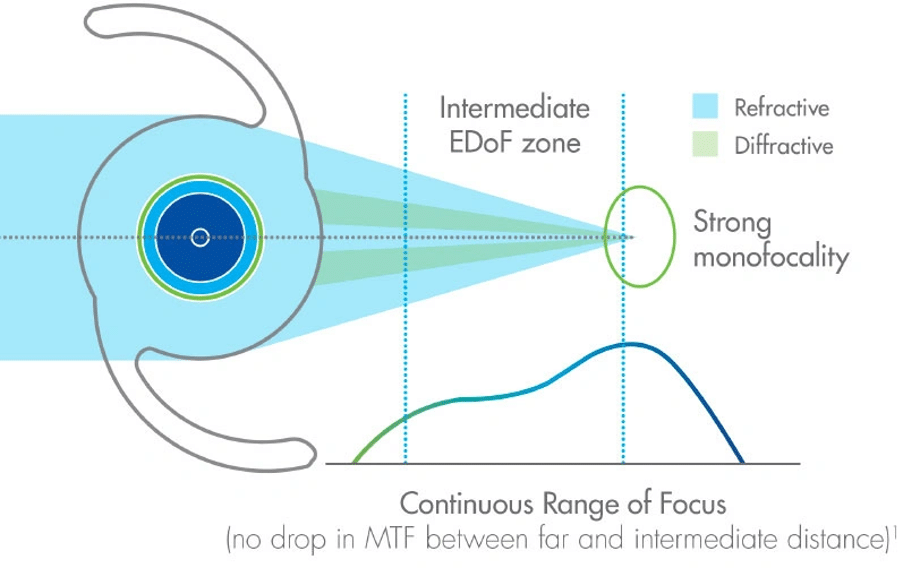Choosing between monofocal and multifocal lenses stands out as a vital decision before your cataract surgery. You’re definitely not alone in this decision – cataract surgery ranks as the most common elective procedure worldwide. The numbers tell the story: 330,000 operations in England annually and 18 million globally. Much of the British population faces this choice, as cataracts affect all but one of their eyes in 30% of adults over 65.
Monofocal lenses top the list of commonly implanted options and health insurance typically covers them. These lenses boost vision at just one distance – you can see clearly either up close, at mid-range, or far away. Multifocal lenses offer a different advantage by providing clear vision at multiple distances at once. The results speak for themselves – 95% of people who get them don’t need glasses for their daily activities. The improved vision comes with some trade-offs to think about. Night-time halos might appear for 5-10% of patients, and costs differ between the two types. Your lifestyle, vision requirements, and budget are the foundations of picking the right lens type that matches your long-term vision goals.

Lens Technology Explained: Monofocal vs Multifocal
The choice between different lens types becomes clearer when you understand how each one works. Let me walk you through how these technologies can restore your vision.
Monofocal lens replacement: fixed focus benefits
Monofocal lenses have the same optical power across their surface and give you clear vision at one set distance—usually far vision that helps with driving and watching TV. These implants can’t adjust focus like your natural lens does. You’ll need reading glasses to see things up close, like your smartphone or a book. The clarity and sharpness at the chosen focal point make these lenses stand out. They give you better contrast sensitivity when it’s dark. Night drivers love these lenses because they need almost no time to get used to them.
Multifocal lens replacement: layered vision zones
Multifocal lenses work differently. They use advanced optical designs with rings or zones that are fine-tuned to focus light at various distances at once. The sophisticated optics create multiple focal points that let you see clearly whether things are near, far, or somewhere in between. These lenses use either refractive optics with specific curve patterns or diffractive optics that have tiny steps to bend light just right. This smart technology helps with presbyopia and lets you switch smoothly between reading, computer work, and driving without changing glasses.
How the brain adapts to multifocal lenses
Your brain does something amazing after getting multifocal lenses—it goes through neuroadaptation. Your brain learns to pick the clearest image from multiple focal points based on what you’re looking at. Each person’s adjustment time is unique and takes anywhere from weeks to months. You might see halos around lights or find it tricky to switch focus between objects quickly. These are normal signs that fade as your brain gets better at handling multiple focal zones. Studies show most people adapt well within six to 12 months, though all but one of these patients might never completely adjust.
Benefits and Trade-offs of Each Lens Type

Image Source: OJAS Hospital
The right lens choice can affect your quality of life by a lot. Choosing the right lens is key to lasting vision clarity. Explore the pros and cons of monofocal vs multifocal lenses with Precision Vision London.
Reduced glasses use: multifocal vs monofocal
Lens types make a big difference in how often you’ll need glasses. Research shows people who get multifocal lenses need glasses less often than those with monofocal implants (RR 0.63). Reading newspaper-sized print becomes easier – 63% of people with multifocals don’t need glasses at all, while only 48% with monofocals can read without them. The numbers look even better for fine print, where 46% of multifocal users never reach for glasses compared to just 22% of monofocal users. A European study found amazing results – 85% of people with multifocals didn’t need glasses for any distance, but only 12% of monofocal users could say the same.
Visual clarity in low light and night driving
Monofocal lenses shine when it comes to contrast sensitivity, especially in tricky lighting situations. These lenses focus all incoming light into one spot, which makes images sharper. So patients with monofocal lenses feel more confident moving around and see better in different lighting conditions.
Adaptation period and patient satisfaction
Both lens types keep patients happy in the long run, even though they take time to get used to. About 97% of monofocal and 90% of multifocal patients say they’re either “very satisfied” or “somewhat satisfied” with their vision two years after surgery. Most people adjust to multifocal lenses within six to twelve months. Notwithstanding that, about 10% of patients might never fully get comfortable with multifocal lenses.
Potential side effects: glare, halos, and contrast
Visual disturbances happen more often with multifocal lenses. People who choose multifocals are 3.5 times more likely to see glare and halos than those with monofocal lenses. Research shows 5-10% of multifocal users notice halos or glare around lights at night. Most patients get used to these visual effects quickly, though some find them distracting even years after surgery.
Cost, Coverage, and Long-Term Value
Money matters a lot in choosing the right lens for cataract surgery. A good grasp of costs and possible savings helps you pick what works best with your budget and vision needs.
Monofocal vs multifocal lens price comparison
The cost gap between these lens types is quite large. Monofocal lenses cost about £1456 to £3,382 per eye, while multifocal lenses range from £1,868 to £4,876 per eye. Private clinics charge £1,995 to £3,150 for standard cataract surgery with monofocal lenses. The price jumps to £3,495 to £4,725 for multifocal options.
This price difference comes from multifocal lenses’ advanced technology. These lenses use special rings or surface improvements that let you see clearly at various distances. Some experts say multifocal implants can cost 10-30 times more than basic monofocal ones.
Insurance and NHS coverage explained
NHS gives free cataract surgery with standard monofocal lenses to qualified patients. The service does not include premium lenses like multifocals.
Private health insurance usually covers monofocal lenses since doctors see them as essential care. The extra cost of multifocal lenses rarely gets coverage. Patients who want multifocal implants usually pay the difference themselves. Many clinics help make this affordable with payment plans that run from 10-72 months.
Why multifocal lenses may reduce future costs
The high upfront cost of multifocal lenses can save money later. Research shows these lenses boost life quality scores (QALY) by 0.71 points and cost £2,712 more than monofocal lenses. The value works out to £3,815 per QALY—far below the typical £39,708 per QALY spending limit.
Multifocal lenses also cut out ongoing costs for reading glasses, progressive lenses, and prescription updates. About 95% of people with multifocal lenses don’t need glasses for daily tasks. These savings add up and can make up for the higher price tag after a few years.
Making the Right Choice with Expert Guidance
Selecting the ideal lens for your eyes needs expert guidance from specialists who understand your unique visual needs. Choosing the right lens is key to lasting vision clarity. Explore the pros and cons of monofocal vs multifocal lenses with Precision Vision London.
Personalised assessments at Precision Vision London
Your experience starts with a detailed consultation at Precision Vision London. Skilled surgeons assess your suitability and create a tailored treatment plan. This personalised approach evaluates your prescription stability, eye health, and lifestyle requirements. The clinic prioritises selectivity to give each patient the most appropriate treatment for their visual and lifestyle needs. You’ll connect with highly trained patient coordinators who can address your first questions and concerns before your consultation.
Trialling monovision before surgery
Monovision gives an excellent alternative to multifocal lenses for many patients. This approach corrects your dominant eye for distance vision and non-dominant eye for near vision. The success rate reaches 92.5% after LASIK treatment. Precision Vision London uses monofocal lenses to achieve monovision if you’re unsuitable for trifocal intraocular lenses. Your attitude toward monovision gets assessed during evaluation—especially your desire to pursue and maintain this correction. Your brain learns to adapt and suppress the blurry image as you maintain monovision longer.
When to avoid multifocal lenses
Multifocal lenses don’t work for everyone. Patients with glaucoma often have reduced contrast sensitivity, which multifocal lenses might worsen. People with high visual demands or who do activities needing excellent visual acuity might find the decreased contrast sensitivity challenging. Those with specific personality types—especially meticulous individuals with high expectations—don’t deal very well with the visual compromises needed with multifocal lenses. About one in ten patients aren’t satisfied with their vision quality with multifocal implants.
How our surgeons ensure optimal outcomes
Precision Vision London’s surgeons can fine-tune your vision after lens replacement surgery if needed. This enhancement process gives excellent long-term results. Most patients achieve substantially improved vision and reduced dependence on glasses. Precision Vision London’s comprehensive approach—combining world-renowned surgical expertise with state-of-the-art technology—will give top-tier results for patients seeking monofocal or multifocal lens replacement.
Comparison Table
| Feature | Monofocal Lenses | Multifocal Lenses |
|---|---|---|
| Vision Focus | Single distance (near, medium, or far) | Multiple distances at once |
| Cost Range (per eye) | £794 - £2,382 | £1,588 - £3,176 |
| Private Surgery Cost | £1,995 - £3,150 | £3,495 - £4,725 |
| NHS Coverage | Covered | Not covered |
| Spectacle Independence | 12% for distance and near vision | 85% for distance and near vision |
| Reading Without Glasses | 22% can read fine print | 46% can read fine print |
| Patient Satisfaction | 97% satisfied patients | 90% satisfied patients |
| Night Vision/Contrast | Better contrast sensitivity | Possible halos/glare effects |
| Side Effects | Few visual disturbances | 5-10% notice halos/glare |
| Adaptation Period | Quick adjustment | 6-12 months |
| Adaptation Success | Almost all patients adapt | 90% adapt successfully (10% may struggle) |
| Best Suited For | People who drive at night or need sharp contrast | People who want to avoid wearing glasses |
Conclusion
The Clear Vision Pathway: Making Your Lens Decision
Your lifestyle, visual needs, and budget will shape your choice between monofocal and multifocal lenses. Understanding the difference becomes significant to achieve the best results from your lens replacement surgery.
Monofocal lenses give you exceptional clarity at one distance. You’ll need minimal time to adapt and get superior contrast sensitivity that helps with night driving. These lenses need reading glasses for close-up tasks but deliver predictable outcomes with 97% patient satisfaction rates. Multifocal lenses work well at multiple distances, and 85% of patients don’t need glasses for near or far vision.
Cost plays a big role, but think beyond just the upfront price. Multifocal lenses cost more initially but could save you money over time by eliminating the need for multiple pairs of glasses. These advanced lenses need some patience while your brain learns to process multiple focal points at once.
Precision Vision London’s team gives you a complete assessment to find your ideal lens type. They look at your visual needs, job, hobbies, and what you expect from the surgery. Their surgeons can fine-tune your vision after surgery if needed, and you’ll get great results whatever lens you choose. Your vision deserves the best care possible. Precision Vision London’s world-class surgeons use advanced technology and put patients first. They’ll guide you through every step toward clearer vision. This choice, made with expert help, will shape how you see the world for years to come—without compromising on quality or care.
FAQs
Q1. What are the main differences between monofocal and multifocal lenses? Monofocal lenses provide clear vision at one distance, typically for far vision, while multifocal lenses offer clear vision at multiple distances. Monofocal lenses often require reading glasses for near tasks, whereas multifocal lenses can reduce or eliminate the need for glasses altogether.
Q2. How much does lens replacement surgery cost in the UK? The cost varies depending on the type of lens. Monofocal lens surgery typically costs between £1,995 to £3,150 per eye at private clinics. Multifocal lens surgery is more expensive, ranging from £3,495 to £4,725 per eye. The NHS covers standard cataract surgery with monofocal lenses for eligible patients.
Q3. What are the potential side effects of multifocal lenses? Some patients with multifocal lenses may experience visual disturbances such as glare and halos, particularly at night. About 5-10% of recipients report these effects. Most people adapt over time, but a small percentage may continue to find these disturbances bothersome.
Q4. How long does it take to adapt to multifocal lenses? The adaptation period for multifocal lenses typically ranges from six to twelve months. During this time, the brain learns to process multiple focal points. Most patients successfully adapt within this timeframe, although approximately 10% may never fully adjust to the new visual experience.
Q5. Are monofocal lenses better for night driving? Yes, monofocal lenses are generally considered superior for night driving. They offer better contrast sensitivity in low-light conditions and are less likely to cause visual disturbances like glare and halos compared to multifocal lenses. This makes them a preferred choice for those who frequently drive at night or in challenging lighting conditions.
Authors & Reviewer
-
 Olivia: Author
Olivia: AuthorHi, I'm Olivia, a passionate writer specialising in eye care, vision health, and the latest advancements in optometry. I strive to craft informative and engaging articles that help readers make informed decisions about their eye health. With a keen eye for detail and a commitment to delivering accurate, research-backed content, I aim to educate and inspire through every piece I write.
-
 Dr. CT Pillai: Reviewer
Dr. CT Pillai: ReviewerDr. CT Pillai is a globally recognised ophthalmologist with over 30 years of experience, specialising in refractive surgery and general ophthalmology. Renowned for performing over 50,000 successful laser procedures.

